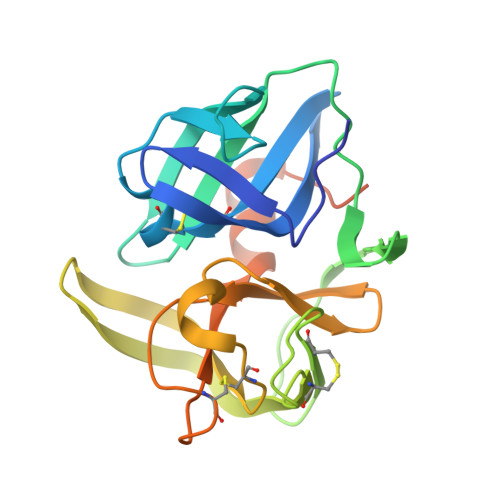Exploring the Evolutionary History of Kinetic Stability in the alpha-Lytic Protease Family.
Nixon, C.F., Lim, S.A., Sailer, Z.R., Zheludev, I.N., Gee, C.L., Kelch, B.A., Harms, M.J., Marqusee, S.(2021) Biochemistry 60: 170-181
- PubMed: 33433210
- DOI: https://doi.org/10.1021/acs.biochem.0c00720
- Primary Citation of Related Structures:
6XHZ - PubMed Abstract:
In addition to encoding the tertiary fold and stability, the primary sequence of a protein encodes the folding trajectory and kinetic barriers that determine the speed of folding. How these kinetic barriers are encoded is not well understood. Here, we use evolutionary sequence variation in the α-lytic protease (αLP) protein family to probe the relationship between sequence and energy landscape. αLP has an unusual energy landscape: the native state of αLP is not the most thermodynamically favored conformation and, instead, remains folded due to a large kinetic barrier preventing unfolding. To fold, αLP utilizes an N-terminal pro region similar in size to the protease itself that functions as a folding catalyst. Once folded, the pro region is removed, and the native state does not unfold on a biologically relevant time scale. Without the pro region, αLP folds on the order of millennia. A phylogenetic search uncovers αLP homologs with a wide range of pro region sizes, including some with no pro region at all. In the resulting phylogenetic tree, these homologs cluster by pro region size. By studying homologs naturally lacking a pro region, we demonstrate they can be thermodynamically stable, fold much faster than αLP, yet retain the same fold as αLP. Key amino acids thought to contribute to αLP's extreme kinetic stability are lost in these homologs, supporting their role in kinetic stability. This study highlights how the entire energy landscape plays an important role in determining the evolutionary pressures on the protein sequence.
Organizational Affiliation:
Department of Molecular and Cell Biology, University of California, Berkeley, Berkeley, California 94720, United States.















